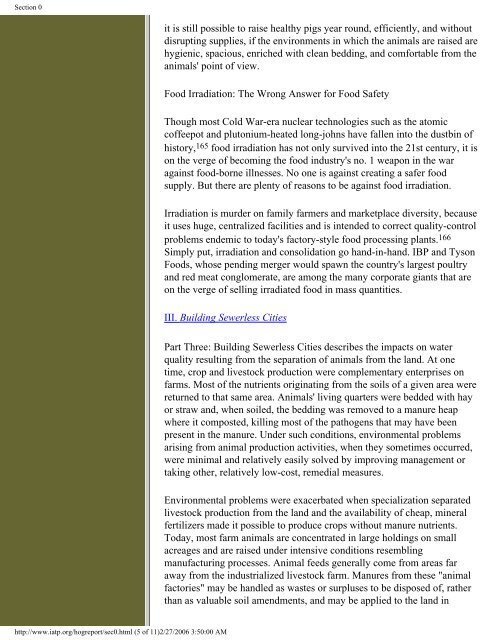IATP Hog Report - Institute for Agriculture and Trade Policy
IATP Hog Report - Institute for Agriculture and Trade Policy
IATP Hog Report - Institute for Agriculture and Trade Policy
Create successful ePaper yourself
Turn your PDF publications into a flip-book with our unique Google optimized e-Paper software.
Section 0<br />
it is still possible to raise healthy pigs year round, efficiently, <strong>and</strong> without<br />
disrupting supplies, if the environments in which the animals are raised are<br />
hygienic, spacious, enriched with clean bedding, <strong>and</strong> com<strong>for</strong>table from the<br />
animals' point of view.<br />
Food Irradiation: The Wrong Answer <strong>for</strong> Food Safety<br />
Though most Cold War-era nuclear technologies such as the atomic<br />
coffeepot <strong>and</strong> plutonium-heated long-johns have fallen into the dustbin of<br />
history, 165 food irradiation has not only survived into the 21st century, it is<br />
on the verge of becoming the food industry's no. 1 weapon in the war<br />
against food-borne illnesses. No one is against creating a safer food<br />
supply. But there are plenty of reasons to be against food irradiation.<br />
Irradiation is murder on family farmers <strong>and</strong> marketplace diversity, because<br />
it uses huge, centralized facilities <strong>and</strong> is intended to correct quality-control<br />
problems endemic to today's factory-style food processing plants. 166<br />
Simply put, irradiation <strong>and</strong> consolidation go h<strong>and</strong>-in-h<strong>and</strong>. IBP <strong>and</strong> Tyson<br />
Foods, whose pending merger would spawn the country's largest poultry<br />
<strong>and</strong> red meat conglomerate, are among the many corporate giants that are<br />
on the verge of selling irradiated food in mass quantities.<br />
III. Building Sewerless Cities<br />
Part Three: Building Sewerless Cities describes the impacts on water<br />
quality resulting from the separation of animals from the l<strong>and</strong>. At one<br />
time, crop <strong>and</strong> livestock production were complementary enterprises on<br />
farms. Most of the nutrients originating from the soils of a given area were<br />
returned to that same area. Animals' living quarters were bedded with hay<br />
or straw <strong>and</strong>, when soiled, the bedding was removed to a manure heap<br />
where it composted, killing most of the pathogens that may have been<br />
present in the manure. Under such conditions, environmental problems<br />
arising from animal production activities, when they sometimes occurred,<br />
were minimal <strong>and</strong> relatively easily solved by improving management or<br />
taking other, relatively low-cost, remedial measures.<br />
Environmental problems were exacerbated when specialization separated<br />
livestock production from the l<strong>and</strong> <strong>and</strong> the availability of cheap, mineral<br />
fertilizers made it possible to produce crops without manure nutrients.<br />
Today, most farm animals are concentrated in large holdings on small<br />
acreages <strong>and</strong> are raised under intensive conditions resembling<br />
manufacturing processes. Animal feeds generally come from areas far<br />
away from the industrialized livestock farm. Manures from these "animal<br />
factories" may be h<strong>and</strong>led as wastes or surpluses to be disposed of, rather<br />
than as valuable soil amendments, <strong>and</strong> may be applied to the l<strong>and</strong> in<br />
http://www.iatp.org/hogreport/sec0.html (5 of 11)2/27/2006 3:50:00 AM

















